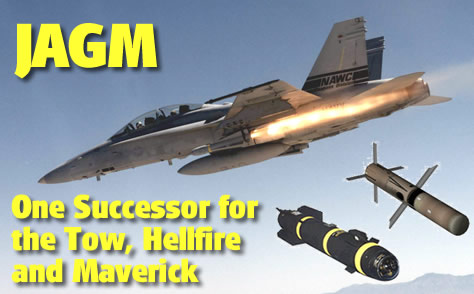Development of the Joint Air-to-Ground Missile (JAGM), was launched September 18, 2008 with the U.S. Army’s Aviation and Missile Command award of$125 and $122 million, competitive contracts to Lockheed Martin and the Raytheon-Boeing industry team. The 27 month development program will proceed toward final selection by the end of 2010. The new weapon is designed to replace seven types of missiles currently in the inventory of US forces. While JAGM has yet to become a formal ‘program of record’, the need for such weapon is clear and most of the technologies are mature, as it roots to the Joint Common Missile, cancelled by the Army few years back. The entire program is expected to cost about US$7 billion.
JAGM is designed as a single missile replacing seven different variants of TOW, Hellfire and Maverick carried by helicopters, attack aircraft and UAVs. JAGM will have a range exceeding 20 km, more than doubling the current Hellfire range. single insensitive-munition rocket motor that provides required propulsion in extreme temperatures to deliver maximum range from all required platforms.
Unlike the current weapons it will replace, optimized for specific environmental and target conditions, JAGM will be equipped with a tri-modal seeker (laser homing, thermal and mm wave radar). The missile has a multi-purpose warhead that packs a highly lethal shaped- charge to defeat the most advanced armored threats and a blast fragmentation capability to defeat ships, buildings, bunkers and other “soft” targets by penetrating them with a precursor warhead and then detonating a time-delayed main warhead to incapacitate the target from within. It will also have a built-in precursor warhead, standardized electronic safe, arm and fire and improved low-signature propulsion improving performance and reliability compared to current weapons. Another advantage over current weapons will be advanced countermeasures, against active protection systems (CAPS).
The missile will retain flexible targeting methods, including autonomous target acquisition, ‘lock on before launch’ and ‘lock on after launch’ capability. This missile will carry an integral internet protocol (IP) based data radio, providing access to ‘targeting during fly’, from multiple sources.
The U.S. Army, Navy and Marine Corps are expected to procure approximately 35,000 JAGM rounds to replace the HELLFIRE II and Longbow HELLFIRE missiles on the U.S. Army’s Apache attack helicopter, the Warrior extended-range multi-purpose UAS, the Arapaho armed reconnaissance helicopter, the Marine Corps’ Super Cobra attack helicopter and on the U.S. Navy’s Seahawk armed reconnaissance helicopter. JAGM will also replace the Maverick missile on the F/A-18 Hornet jet fighter.
Potential extension to other platforms, such as the F-35 Joint Strike Fighter, and future international sales could push the total number of rounds much higher. The Lockheed Martin JAGM team includes more than a dozen major suppliers located across the United States and in the United Kingdom.
JAGM is expected to remain compatible with the currently used with US Army, Air Force Marines and Naval aircraft and helicopters, thus reducing developmental, engineering and logistical impact associated with the fielding of a new weapon system. Several companies are positioned to compete for the new program.
Related Topics:
- A Successor for the Tow, Hellfire and Maverick

















